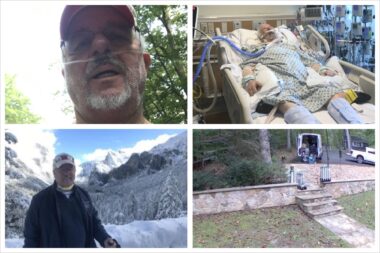Celebrating independence 2 years after my double-lung transplant
My donor's gift has given me greater freedom and a better quality of life

July is a month of celebration at our house. Though it begins with the Fourth of July, my personal “Independence Day” is on July 10 — the day I received a double-lung transplant in 2021. It’s a celebration tempered with reverence for the beautiful lungs my donor gifted me.
The road to freedom
July 4, 2021, was a day like many others in the late pre-transplant phase of my disease.
I was diagnosed with idiopathic pulmonary fibrosis on Jan. 31, 2017. Its progression “stair-stepped” — that is, it remained stable for a period, declined, then stabilized again.
When I was listed for transplant in March 2021, my supplemental oxygen use was up to 7 liters per minute.
Exercising on July 4 was necessary, and dragging an oxygen tank on a cart behind me was simply a part of my routine.
Shortly after 9 a.m. on July 9, I got a call from the Inova Advanced Lung Disease and Lung Transplant Clinic in Virginia saying they had a lung offer for me. My wife, Susan, and I paused to say a prayer for my donor and their family before heading out the door. We arrived at the hospital around noon, and I was admitted. At 3 a.m. on July 10, I was taken to the operating room for a nearly nine-hour surgery. When I emerged with successfully transplanted lungs, I was on a ventilator.
During the afternoon of July 11, I was taken off the ventilator and extubated. I took my first breath with my new lungs. I spent the next few days in the intensive care unit, where my care team weaned me off oxygen as my new lungs began working with my body.
A new beginning
I was discharged from the hospital on July 20 — 10 days after my transplant. Two days later, the frenzy of clinic appointments and pulmonary rehabilitation began. I was exercising my lungs and learning to breathe again. During those sessions, I could already see the difference in my quality of life.
Pulmonary rehab involved a combination of exercise bikes, treadmills, and strength training with weights. During these sessions, my oxygen saturation percentage was consistently in the upper 90s. Even during my heaviest exertion, my levels stayed high. I could breathe freely.

Clockwise from top left: Sam exercises on July 4, 2021; Sam in the hospital, after transplant and before extubation, on July 11, 2021; oxygen tanks and equipment are picked up from Sam’s house in the fall of 2021; Sam visits Yosemite National Park in November 2022. (Photos courtesy of Sam Kirton)
A green light
During a post-transplant clinic visit in late September 2021, the post-transplant nurse coordinator told me she’d canceled my oxygen order, which meant the supplier would be scheduling the pickup of my oxygen equipment.
Watching our home security camera like it was an Academy Award-nominated film, Susan and I saw the vendor recover the oxygen tanks and concentrator. Seeing that van pull away was a sign of the independence I’d gained.
Clearing the tethers
I was finally able to go for walks without needing to drag an oxygen tank. I could walk through our home without green oxygen tubing trailing behind me. I could close my eyes and not hear the gentle hum of the concentrator.
An additional bonus was that I no longer required a continuous positive airway pressure (CPAP) machine to sleep at night. My care team had me stop using it after my transplant.
Beyond thankful
As I approach the second anniversary of my transplant, I continue to say a prayer for my donor and their family. I will visit the National Donor Memorial in Richmond, Virginia, on Sunday morning and set a place at the table that afternoon for my donor.
I still know nothing about my donor except that they’ve given me the most precious gift of time. Their donation has extended and improved the quality of my life. Transplant isn’t easy. The entire process involves a lot of work. Out of respect and love for my donor, I make every breath count.
Note: Pulmonary Fibrosis News is strictly a news and information website about the disease. It does not provide medical advice, diagnosis, or treatment. This content is not intended to be a substitute for professional medical advice, diagnosis, or treatment. Always seek the advice of your physician or other qualified health provider with any questions you may have regarding a medical condition. Never disregard professional medical advice or delay in seeking it because of something you have read on this website. The opinions expressed in this column are not those of or its parent company, Bionews, and are intended to spark discussion about issues pertaining to pulmonary fibrosis.









Leave a comment
Fill in the required fields to post. Your email address will not be published.